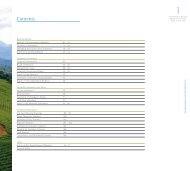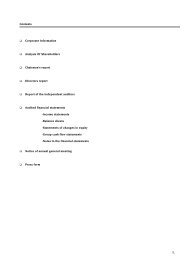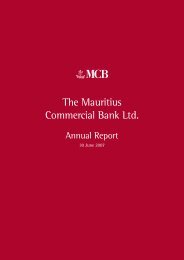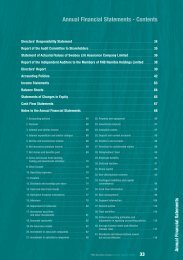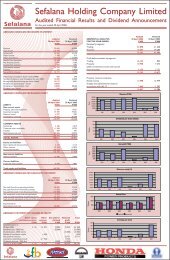Contents - Equity Bank Group
Contents - Equity Bank Group
Contents - Equity Bank Group
- No tags were found...
Create successful ePaper yourself
Turn your PDF publications into a flip-book with our unique Google optimized e-Paper software.
Notes to the Financial StatementsFor the year ended 31st December 2007Exposure to other market risks – non-trading portfoliosCredit spread risk (not relating to changes in the obligor / issuer’s credit standing) on debt securities held by Treasury and equity pricerisk is subject to regular monitoring by Board Risk Management Committee. Currently, the exposure to other market risks on non-tradingportfolio is not significant in relation to the overall results and financial position of the <strong>Bank</strong>.(e)Operational risksOperational risk is the risk of direct or indirect loss arising from a wide variety of causes associated with the <strong>Bank</strong>’s processes, personnel,technology and infrastructure and from external factors other than credit, market and liquidity risks such as those arising from legal andregulatory requirements and generally accepted standards of corporate behaviour. Operational risks arise from all of the <strong>Bank</strong>’s operationsand are faced by all business units.The <strong>Bank</strong>’s objective is to manage operational risk so as to balance the avoidance of financial losses and damage to the <strong>Bank</strong>’s reputationwith overall cost effectiveness and to avoid control procedures that restrict initiative and creativity.The primary responsibility for the development and implementation of controls to address operational risk is assigned to seniormanagement within each business unit. This responsibility is supported by the development of overall <strong>Bank</strong> standards for the managementof operational risk in the following areas:• requirements for appropriate segregation of duties, including the independent authorisation of transactions• requirements for the reconciliation and monitoring of transactions• compliance with regulatory and other legal requirements• documentation of controls and procedures• requirements for the yearly assessment of operational risks faced, and the adequacy of controls and procedures to address the risksidentified• requirements for the reporting of operational losses and proposed remedial action• development of contingency plans• training and professional development• ethical and business standards• risk mitigation, including insurance where this is effective.Compliance with <strong>Bank</strong> standards is supported by a programme of regular reviews undertaken by both the Internal Audit and compliancedepartments. The results of Internal Audit reviews are discussed with the management of the business unit to which they relate, withsummaries submitted to the Audit Committee and senior management of the <strong>Bank</strong>.(f)Capital managementRegulatory capitalThe Central <strong>Bank</strong> of Kenya sets and monitors capital requirements for the <strong>Bank</strong>ing industry as a whole.In implementing current capital requirements The Central <strong>Bank</strong> of Kenya requires the <strong>Bank</strong> to maintain a prescribed ratio of total capitalto total risk-weighted assets.The <strong>Bank</strong>’s regulatory capital is analysed into two tiers:• Tier 1 capital, which includes ordinary share capital, share premium, retained earnings, after deductions for goodwill and intangibleassets, and other regulatory adjustments relating to items that are included in equity but are treated differently for capital adequacypurposes.• Tier 2 capital, which includes qualifying subordinated liabilities, collective impairment allowances and the element of the fair valuereserve relating to unrealised gains on equity instruments classified as available-for-sale.482007 Annual Report and Financial Statements




